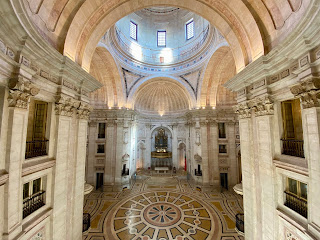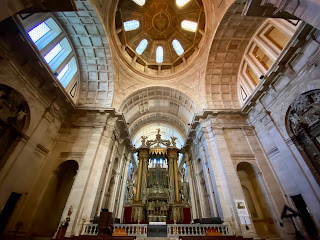I am recovering from a virus I caught during our trip home to Boston and San Francisco. Though the weather has been very mild, especially compared, I have been reluctant to go out, but am feeling fairly recovered today. So it's a good day to get outside: metro to Santa Apolónia and work our way back uphill through a series of churches.
Actually our first stop is lunch at Taberna Albricoque. Right near the station, this place is the source of my new favorite hot sauce (Piri-piri Bertílio), which is sold in little jars. Less like a typical sauce, it's thick with malagueta chilis and good Portuguese olive oil (azeite), so it doesn't pour. My chestnut and oysters soup is followed with a grilled pork sandwich doused in the sauce. Delicioso.
Our next stop is the Igreja de Santa Engrácia, the Panteão Nacional (National Pantheon) of Portugal. We had found and walked around this building in previous visits, but we never found the way in. Today we find the entrance is not on a main street, but off a steep, crooked side street – easier to find, it seems, if you come at it from the downhill side. It is a surprisingly clean neo-classical block: no tile panels, no big graphics, no graffiti. The dome, it turns out, is a much later addition to the chunky base, but it is the dome which creates an identity and a marker in the Lisbon skyline.
The building itself is eminently explorable, with lots of balconies and landings from which to look into the central space. Interesting that the exterior should have a flat roof, but the dome is built on a series of pendentives and half-domes. Climbing the stairs to the gallery, you can clearly see the change in the age of the stones just as you approach the roof level. The exterior walls at each arm of the cross, are circular, so one imagines that the left-over, inverted-wedge of space is up there under the roof, but with no other expression on the outside.
The base of the church dates from the late 1600's. A display of early images of the church shows the building's central opening with no roof, or with a low, flat cap. The tall drum and dome are from 1956-66, so total construction took nearly 300 years. As I researched the church for our visit, I came across the term "Obras da Santa Engrácia", which refers to "never-ending projects". However, I think it's important to point out the building stood idle for a long time, and-or was used as storage space and even a shoe factory, so the meaning of that phrase ought to be about keeping an interest in finishing something, as much as the scale of a project. Regardless, it's quite a beautiful place.
Just up the hill is the Igreja e Mosteiro de São Vicente de Fora. The "outside" refers to the monastery's being outside the city walls. We have walked around this place several times as well, but the church was never open. Between the Pantheon and the Monastery is the Campo de Santa Clara, the site of the Feira da Ladra (Thieves Market) and a gathering space for the neighborhood, and we've walked through the Campo a few times.
The Igreja is connected to the Campo by a narrow street (Largo de São Vicente). The street is bounded on one side by the outside wall of the church itself, and on the other by a fragment the city's ancient wall – which, I suppose, is the wall the Monastery is "outside". The church itself, which dated from the late 1500's, holds some interest: a long, barrel-vaulted nave, with shallow transepts, and the same kind of flattened, octagonal "dome" that might have once been on the Pantheon. The dome is pierced by several standard-looking arched windows, like they were pulled out of a catalog; seems odd to see them at such an angle.
There are some unusual variations in the forms of the classical architecture. It is doric, but the way the pilasters are designed makes the reading a little difficult: the corners of the abacus sweep outward, there are leafy decorative panels which read as part of the capital, and the triglyphs are replaced with brackets.
On the other side of the Igreja from the wall is the Mosteiro. The monastery, visible from the roof of the Pantheon, is quite long – almost as long as the train shed where we started the day. Entrance to the complex is from a a small courtyard at the foot of the stairs to the church; so you enter from below.
The first feature is the cistern. As the church and monastery were built and re-built for hundreds of years, starting in the lower levels is a look into the past: old construction is integrated into newer construction, or broken away to allow access, while other parts are left to fall away. It's fascinating to me, but there is precious little visible here. Climbing the stairs, we arrive at a large entrance hall, the painted ceiling faded by time, and the walls covered in tile panels.
We enter the first of two cloisters; wonderful, bright archways filled with more tiled panels, illustrations of a series of fables written by the French poet, La Fontaine. From the cloisters we find a series of smaller tomb rooms and chapels, including one room holding the Braganza Family (the Royal Pantheon). It is surprising in its simplicity, ornamented almost solely by crowns and marks of office, and the statue of a hooded figure, weeping – upon entering the room you feel as if you are interrupting a mourner.
The fables continue along the stairs and up to the gallery level, where there is a show explaining the fables and showing more tile panels. Next to the stairway, there is an outdoor space facing west towards the river with wonderful views of the Alfama. Continue up, with more tile panels, and we emerge from the bell tower and onto the roof of the church. More amazing views, but we can also now look back down into the cloisters with the sun setting beyond.
Finishing at the monastery, we continue up the hill to the Igreja Paroquial e Convento da Graça. This is the complex that is visible from the Miradouro da Senhora do Monte. Unfortunately we are too late to enter the church, but the evening lights come on just as we arrive at the miradouro, and the view is fantastic.
We end the day at Carpintarias de São Lázaro, an art space where we attend the opening of Fim da Terra:
"a multimedia project, with an interactive installation, film projection, as well as performance"
In a large, below-ground industrial space, a series of posters are laid out between areas bounded by cardboard boxes; an app is used to view the media and hear the various artists involved – very difficult to understand given the performance (singing interview?) and the other visitors. Unfortunately, the posters are accompanied by burning incense, and this triggers Donna's asthma, so we cannot stay long.
Perhaps the presenters might suggest headphones or something; there seems to be a dystopian-tinged theme which appeals to me. Though turns out you can use the app by aiming your smartphone camera at the images on the web site (not all the images are posted), so anyone can try it out. In the end I am still feeling left out: can't keep up with the Portuguese rap, and the images don't tell a cohesive story out of context (maybe even in context). Still it's always worthwhile to get out and try new things.






























No comments:
Post a Comment